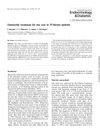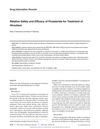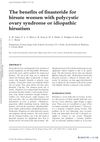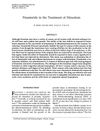TLDR Topical finasteride didn't significantly reduce facial hair, but patients felt it helped.
The study investigated the efficacy of 0.5% finasteride cream in managing idiopathic hirsutism in 35 women. Finasteride and placebo creams were applied to different sides of the face, and hair number and thickness were measured over 6 months. Results showed a decrease in hair number and thickness on both the finasteride and placebo sides, but no statistically significant difference between the two. Despite this, patients reported a perceived reduction in hair growth on the finasteride-treated side. The study concluded that topical finasteride did not significantly affect facial hirsutism, although patients felt there was a decrease in hair growth.
 November 2020 in “Journal of The American Academy of Dermatology”
November 2020 in “Journal of The American Academy of Dermatology” Finasteride 1 mg every other month works as well as daily dose for hair loss maintenance.
 4 citations
,
January 2015 in “Journal of drug assessment”
4 citations
,
January 2015 in “Journal of drug assessment” Finasteride gel effectively and safely reduces hair thickness in women with excessive hair growth.
 27 citations
,
July 2009 in “Experimental and Clinical Endocrinology & Diabetes”
27 citations
,
July 2009 in “Experimental and Clinical Endocrinology & Diabetes” Finasteride safely reduces excessive hair growth in women.
 29 citations
,
April 2004 in “Annals of Pharmacotherapy”
29 citations
,
April 2004 in “Annals of Pharmacotherapy” Finasteride reduces hirsutism effectively with fewer side effects but is a second-choice treatment due to safety concerns.
 40 citations
,
January 2003 in “Gynecological Endocrinology”
40 citations
,
January 2003 in “Gynecological Endocrinology” Finasteride effectively reduces hair growth in women with polycystic ovary syndrome or idiopathic hirsutism.
 10 citations
,
June 2001 in “PubMed”
10 citations
,
June 2001 in “PubMed” Finasteride is effective in growing hair and stopping hair loss in men with mild to moderate alopecia.
 27 citations
,
November 1998 in “Journal of Endocrinological Investigation”
27 citations
,
November 1998 in “Journal of Endocrinological Investigation” Finasteride significantly reduces hair growth in women with idiopathic hirsutism.
 10 citations
,
December 1995 in “Journal of women's health”
10 citations
,
December 1995 in “Journal of women's health” Finasteride reduces hair growth in women with hirsutism and works better with electrolysis.







